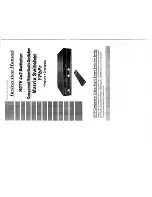
PoE inline power supports devices compliant with the IEEE 802.3af standard, as well as prestandard Cisco
IP Phones and Cisco Aironet Access Points. Each port can deliver up to 15.4 W of PoE. PoE+ inline power
supports devices compliant with the IEEE 802.3at standard, by delivering up to 30 W of PoE+ power per port
to all switch ports.
See
Power Supply Modules, on page 9
for the power supply modules required to support PoE and PoE+ on
24- and 48-port switches.
Voltages that present a shock hazard may exist on Power over Ethernet (PoE) circuits if interconnections are
made using uninsulated exposed metal contacts, conductors, or terminals. Avoid using such interconnection
methods, unless the exposed metal parts are located within a restricted access location and users and service
people who are authorized within the restricted access location are made aware of the hazard. A restricted
access area can be accessed only through the use of a special tool, lock and key or other means of security.
Statement 1072
Warning
Voice over IP (VoIP) service and the emergency calling service do not function if power fails or is disrupted.
After power is restored, you might have to reset or reconfigure equipment to regain access to VoIP and the
emergency calling service. In the USA, this emergency number is 911. You need to be aware of the emergency
number in your country. Statement 371
Warning
Category 5e and Category 6 cables can store high levels of static electricity. Always ground the cables to a
suitable and safe earth ground before connecting them to the switch or other devices.
Caution
Noncompliant cabling or powered devices can cause a PoE port fault. Use only standard-compliant cabling
to connect Cisco prestandard IP Phones and wireless access points, IEEE 802.3af, or 802.3at (PoE+)-compliant
devices. You must remove any cable or device that causes a PoE fault.
Caution
Cisco Catalyst 9200 Series Switches Hardware Installation Guide
32
Installing the Switch
PoE and POE+ Port Connections
















































